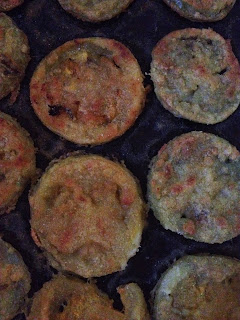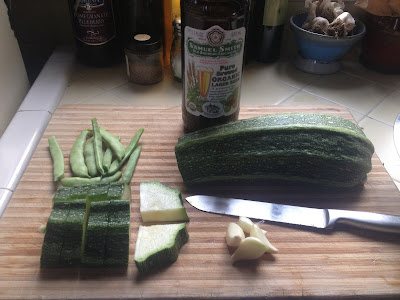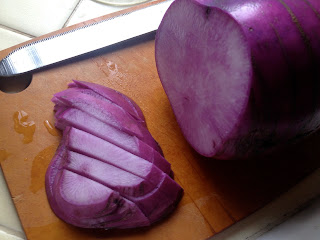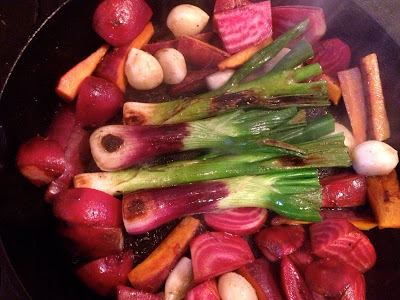We really love soup. As you follow us on this farm and food journey you will notice that we like to make certain things a lot. Mostly we love to make soup because it is just so easy. Basically soup can be made from anything you have around the kitchen. Basic recipe is as follows: vegetables and/or fruits, herbs, water, salt. It really doesn't have to be any more complicated than that and if you are so inclined you can add grains, pastas, beans to make it heartier.
I once had some interns working with me that commented during a lunch that I always had soup and how did I ever do it. I simply explained to them that soup is very, very uncomplicated and in my mind the addition of bouillon and packaged ingredients that are meant to make soup making easy, is often a detriment and can make a a good soup recipe into something very non-spectacular. The secret to excellent soup is that you need those fresh ingredients to bring about those flavors that make for a delicious soup stock. You really don't need all day to simmer a soup so that you can get that stock. Soup can be made within a half hour (or even less) if you keep it simple.
We love a huge pot of soup that can be very simple the first day, add a grain or a pasta and some type of legume if you desire the next day, and then later days add more water which will thin it out, but just add a bit more salt and maybe a new vegetable or two and you are well fed for most of the week (or the entire week if you have a really big pot or don't eat as much as we do).
This meal is one of those types of soups that can be made any which way desired. We used what we had around and it turned out delicious.
A meal: The late harvest soup
tromboncino winter squash, peeled and cut into chunks as much as needed (I used about a half of the squash - any winter squash will do)
baby yellow crookneck squashes, some whole with flowers and others sliced thinly on a mandolin
baby mountain rose potatoes, whole (can be diced into chunks if larger)
sunchokes, cut into chunks or sliced thinly
leek, sliced into thick rounds
baby carrots, washed well and leafy tops removed (some of the green top was left on the carrots)
young green soybeans, shelled
green unripe tomatoes and their ripe tomatoes, diced into large chunks
garlic, peeled and sliced
herbs:
two leaves of lemongrass
sprig of rosemary
sprig of pineapple sage
olive oil
salt
water
Toss all your vegetables and herbs into a large soup pot with a dash of olive oil and about 1 tablespoon of salt to start if making a large pot. Let the vegetables simmer a bit on the oil before adding as much water as will fill the pot to the desired amount of soup you will want in the end. I will often use the largest bowl that is going to be used for serving the soup filling it with water, and then do this 4-6 (sometimes 8!) times if I plan on having the soup for dinner, lunch and then dinner again. And this way, the hungry farmers can have seconds if they so desire!
As you can see there is just a hand full of this, and a few of that, and any combination of herbs will do. The soup ends up making a relatively light vegetable broth, but it is packed full of whole vegetables.
This pot of late harvest soup then gets simmered until the vegetables are just softened (anywhere from 15 minutes or more as desired). More salt can be added by the eater as needed once ready to sit down to eat.
This meal was then paired with a homemade whole wheat ciabatta like loaf of bread and a salad made from kohlrabi, apples, cherry tomatoes.While I am working on perfecting my bread making skills, I am not ready to post a recipe for the bread as I still feel like I have a lot of kinks to smooth out and a lot of tricks I need to learn. The loaf was hearty and had a nice texture, but I certainly do not profess to be much of a baker yet (although it is a skill I wish to learn - any outside feedback would be much appreciated...)
I didn't end up taking step by step photos of the salad because I assumed it would be too simple, but it was simply so good that I'll share at least the ingredients and perhaps it will be improved upon and posted again at a later date. We had just enough kohlrabi to make a small salad to share.
The salad:
1 kohlrabi, skin peeled/removed and then inner flesh cut into chunks
1 sweet winter apple, grated
handful of cherry tomatoes, sliced in half
olive oil
balsamic vinegar
salt
Drizzle the olive oil and balsamic vinegar just enough to coat the ingredients and then add just as much salt as desired (a few dashes).
The soup was plenty hearty to satisfy us for a few days and we never even added any pasta or grains. It was the perfect meal for a cold Fall evening after a long days work on the farm. The subtle flavors of the lemongrass and pineapple sage were well complimented and came through even with the pungent flavor of the rosemary taking some room within the flavoring of the stock.


















































